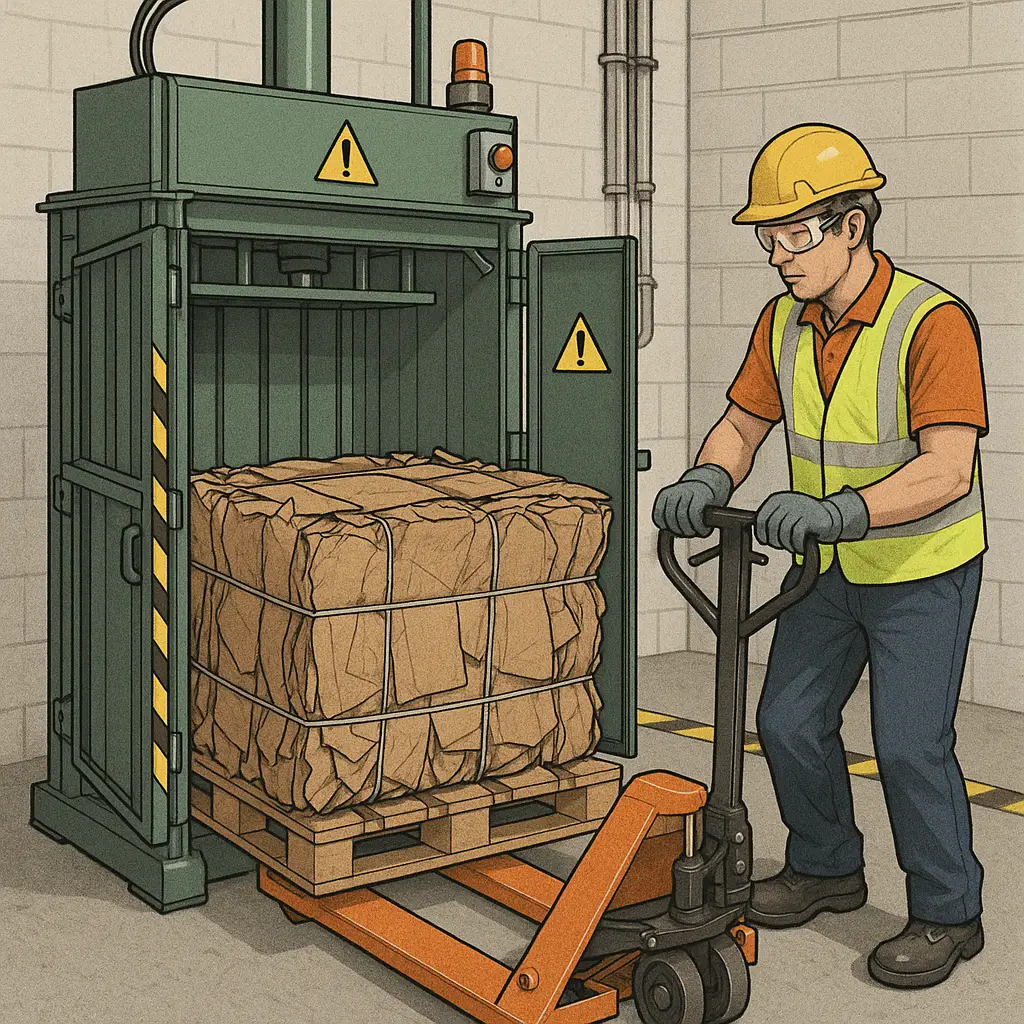Unloading—or emptying—a cardboard baler is a crucial aspect of maintaining smooth operations in any facility that recycles or processes cardboard waste. Proper unloading ensures continued productivity, prevents equipment damage, and safeguards operator safety. This comprehensive guide explores the types of balers, essential safety precautions, step-by-step unloading procedures, troubleshooting tips, and best practices to optimize your baler unloading process.
Main Takeaways
- Safety First: Always follow lockout/tagout procedures, wear appropriate personal protective equipment (PPE), and verify that the baler is fully powered down before any unloading.
- Streamlined Workflow: Organize space around the baler, use appropriate lifting or handling equipment, and maintain clear communication among team members.
- Equipment Maintenance: Regularly inspect and service the baler’s ram, platen, door seals, and hydraulic system to prevent malfunctions during unloading.
- Recycle Value: Properly baled and unloaded cardboard maximizes recycling revenue by ensuring tight, uniform bales free of contaminants.
1. Understanding Cardboard Balers
Cardboard balers come in various designs, each affecting the unloading method:
Vertical Balers
- Compact footprint.
- Operator loads material at top; bale is ejected downward.
- Ideal for small to medium volumes.
Horizontal Balers
- Long chamber; bales emerge from one end.
- Often fully automatic or semi-automatic.
- Suited for high-volume operations.
Closed-End vs. Open-End
- Closed-End balers form bales inside a chamber, then eject via side or bottom door.
- Open-End balers compress material against a fixed platen, and bales are tied and removed from the front.
2. Pre-Unloading Safety and Preparation
Before any unloading:
- Lockout/Tagout (LOTO)
- Shut off power at source.
- Attach lock and tag to prevent accidental startup.
- PPE Requirements
- Steel-toe boots to protect feet from falling bales.
- Cut-resistant gloves for handling wires and cardboard edges.
- Safety glasses or face shield to guard against debris.
- Hearing protection if baler is in a noisy environment.
- Work Area Organization
- Clear the immediate perimeter of loose cardboard and obstructions.
- Ensure adequate lighting and floor traction.
- Position pallet jack or forklift within reach of the discharge area.
- Inspect Baler Components
- Check for hydraulic leaks around hoses and cylinders.
- Verify that the ram and platen move freely during a test cycle.
- Examine door latches, pins, and safety interlocks for wear or damage.
3. Step-by-Step Unloading Procedures
3.1 Vertical Baler Unloading
- Complete the Compression Cycle
- Press the “Bale” or “Compress” button until the ram reaches its full stroke.
- Release controls to allow bale to form tightly.
- Tie the Bale
- Use baling wire or strapping through bale loops.
- Twist wire or tension strapping to secure the bale against expansion.
- Open the Discharge Door
- Release door latch and swing door open fully.
- Confirm that the bale remains stable against the ram.
- Eject the Bale
- Activate the “Eject” cycle; the ram pushes the bale out.
- Ensure team members stand clear of the door opening.
- Remove and Stage
- Slide pallet or pallet jack under the bale.
- Transport to storage or outbound loading area.
3.2 Horizontal Baler Unloading
- Initiate the Auto-Tie Sequence (if equipped)
- The machine will automatically wrap wire or strap.
- Retract the Ram
- Manual: Depress “Retract” to clear the bale path.
- Automatic: System cycles back once tying completes.
- Open the Exit Gate
- Release safety pin; open the gate away from the chamber.
- Ensure no personnel are in the chamber path.
- Bale Removal
- Use a forklift or bale truck to extract the bale.
- Lift from designated fork pockets or under-slung bale carrier.
- Reset for Next Cycle
- Close and latch gate.
- Verify interlock engagement.
- Resume feeding material.
4. Handling Techniques and Equipment
Efficient unloading often requires mechanical assistance:
| Equipment | Purpose and Benefit |
|---|---|
| Pallet Jack | Ideal for vertical balers; slides under bales for manual transport without forklift. |
| Forklift with Bale Spear | Specialized spear attachments penetrate bales for secure lifting; highly efficient for horizontal balers and large operations. |
| Bale Trucks | Low-profile trucks designed to hold multiple bales; reduce trips between the baler and storage area. |
| Powered Pallet Stacker | Combines lifting and lifting height control; useful in warehouses to stack bales on racks or high pallets safely. |
5. Troubleshooting Common Unloading Issues
Bale Stuck in Chamber
- Confirm that the bale is fully tied; under-tied bales may shrink and bind.
- Retract the ram slightly and re-cycle to loosen.
- Inspect door hinges for debris; clear any obstructions.
Hydraulic Pressure Loss
- Check oil level and top up with manufacturer-specified hydraulic fluid.
- Bleed air from the system per the service manual.
- Replace worn hoses or seals to restore full pressure.
Interlock Malfunction
- Clean safety sensors and mechanical switches of dust and cardboard fibers.
- Test continuity with a multimeter; replace faulty switches.
- Ensure proper alignment of door strikers and limit switches.
Inconsistent Bale Density
- Verify feed chute is evenly loaded each cycle.
- Check platen or door seals for leaks that reduce compression.
- Maintain proper hydraulic pressure; adjust relief valve per specs.
6. Maintenance Practices to Facilitate Easy Unloading
Routine maintenance not only extends baler life but ensures smooth unloading:
- Daily:
- Wipe down exterior surfaces and remove cardboard debris.
- Visually inspect hydraulic hoses and electrical cables.
- Weekly:
- Lubricate pivot points on doors and latches.
- Check tie-wire dispensers and strapping reels for jams.
- Monthly:
- Change hydraulic oil filter and inspect reservoir cleanliness.
- Test all safety interlocks under controlled conditions.
- Annually:
- Perform a full hydraulic system flush.
- Calibrate pressure gauges and limit switches.
- Engage a certified technician for in-depth inspection.
7. Environmental and Regulatory Considerations
- Waste Separation: Ensure cardboard is free of contaminants (plastic wrap, styrofoam) to meet recycling facility standards.
- Local Regulations: Some regions mandate record-keeping for waste volumes. Document bale counts, weights, and shipment dates.
- Noise and Emissions: Position balers in well-ventilated areas and adhere to OSHA noise-exposure limits (90 dB over 8 hours).
8. Optimization and Best Practices
- Standardize Bale Weights
- Aim for consistent bale dimensions and weights to streamline forklift operations and shipping.
- Workflow Layout
- Place baler near loading docks or roll-off containers to minimize handling distance.
- Training and Certification
- Provide hands-on training for operators covering emergency stops, LOTO, and unloading procedures.
- Performance Metrics
- Track unload times, bale counts per shift, and equipment downtime to identify improvement areas.
- Continuous Improvement
- Solicit operator feedback on ergonomics, tie methods, and material flow to refine processes.
Conclusion
Efficient and safe unloading of cardboard balers hinges on rigorous safety protocols, systematic procedures, and proactive maintenance. By understanding the nuances of vertical versus horizontal designs, leveraging appropriate handling equipment, and adhering to best practices, facilities can maximize throughput, minimize downtime, and ensure operator well-being. Consistency in bale formation and unloading not only boosts recycling revenue but also fortifies environmental compliance and operational excellence. Implement these guidelines to transform your cardboard baling operations into a streamlined, safe, and productive process.



Leave a Reply